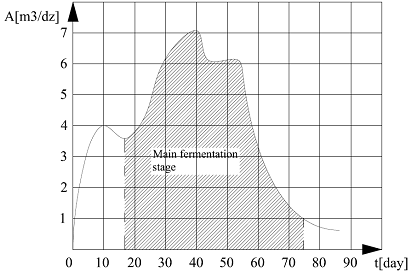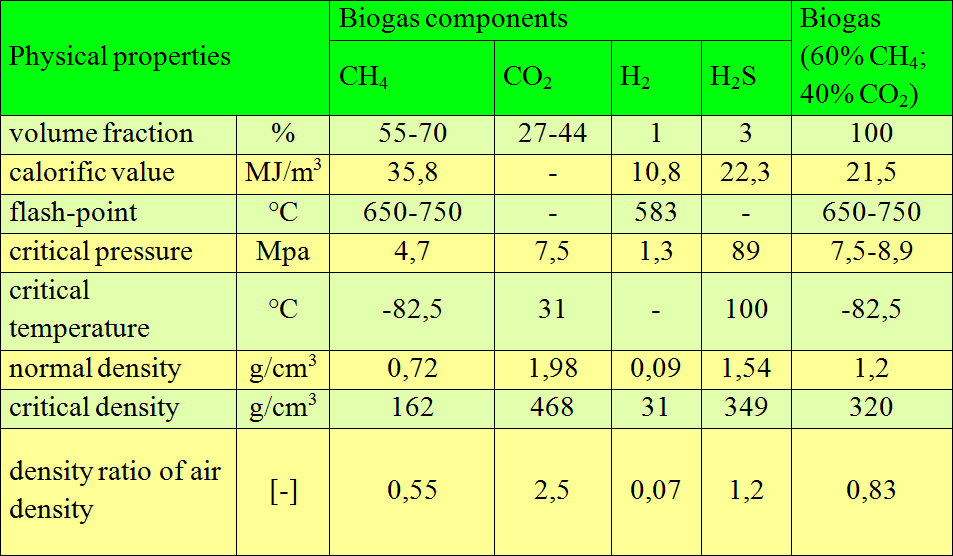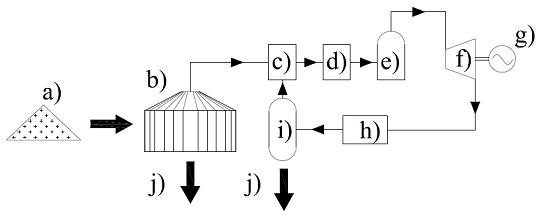
BIOGAS COMBUSTION
Expect combustion (the easiest and the most mature method of energy extraction from biomass), humanity knows other and relatively new technology. Gasification is high efficient way to convert solid bio-fuel into bio-gas. That process uses the same sources as combustion method. Mesophilis fermentation is a process during which biomass is converted into biogass. Currently almost all of the biomass can be gasified. Moreover biogass can be also obtained from landfill and from sewage what also solve the waste problem. The most common gasification product is methane (CH4) or methanol (CH3OH) which include also from 55% to 70% of methane. That fuel can be use for cars to drive diesel engine or can be used to produce electricity in gas power plant because the calorific value of biogas is about 19,7-25 MJ/m3. [12] Methane fermentation is a reduction process of organic substation decomposition in environment isolated from oxygen. Under influence of many different micro-organisms the biomass decomposes and discharge carbon dioxide (CO2) and methane (CH4). Bacteria which are responsible for decomposition has relatively long time of reproduction and also are sensitive on external conditions. Fermentation process can be slow or interrupted by: the oxygen, the light, temperature changes, unsuitable temperature, unsuitable reaction, unsuitable humidity or so high environmental toxicity.[12] In fermentation process can be used two types of bacterium: mesophiles bacteria (required 30-35°C of temperature), termophiles bacteria (required 52-55°C of temperature). Slightly alkaline environment is required to maintain the process (pH from 6,5 to 8). If the reaction is too high bacterium emit more hydrogen and hydrogen sulphide. However If the reaction is too low, fermentation stops. Biomass should be mixed for temperature equalization and to improve biogas production. Below graph shows density of biogas production from typical biomass: (Fig. 45)

In fermentation cycle are two stages:
- acid fermentation – during that stage bacterium decompose hydrocarbon into carbon dioxide, fats and proteins into lower fatty acid
- alkaline fermentation – major production of methane and carbon dioxide.
As a Fig. 45 shows, during fermentation are two maximum of gas production: in about 35th day and about 55th day. After then biogas production rapidly falls down. Below figure shows basic parameters of typical biogas: (Fig. 46) [12]

As the Fig. 46 shows that raw biogas has relatively high calorific value however not enough as a gas. Therefore bio-methane has to be separated from carbon dioxide using water. That process gives final product, biogas with 35,7 MJ/m3 of calorific value and consists of methane (in 95%) and low amount of carbon dioxide (about 5%). Octane number of final biogas is about 125. When the biogas is pumped inside the chamber is bio-slime which is valuable organic fertilizer. Efficiency of total gasification process (from raw biomass to pure methane) is about 70-80%. [12], [50] Biogas is pumped from septic tank into another tank where it is storage. That ensure continuous and steady gas collecting every hour. There are two common types of tanks: low pressure tank (most common for storage) and high pressure tank. The tank capacity depends from amount of gas production and from storage time. Assuming a clock demand for gas the tank capacity should be enough to storage a clock gas production. [12] Expect biomass the biogas can be extracted also from wastes and sewage. This is promising technology because produce energy and utilize wastes. The gas obtained from landfill is close similar to pure biogas obtained from biomass (about 50% of methane, carbon dioxide etc.). For example 100 000 tons of wastes allow to obtain about 400 000 m3 annual of biogas. It gives about 50m3/h. [12]

(Fig. 47) shows example scheme of small biogas power plant. Raw biomass are loaded into fermentation tank. From there, produces gas flows to the 2 stage apparatus which eliminates CO2 and sulphur. After them clean biogas flow to the tank where is storage till drives gas turbine. Unused heat energy is used for biomass heating in another tank, where bacterium required higher temperature e.g: about 30°C. Moreover the i) tank (from figure Fig. 47) can be supported by photovoltaic cells. [12] Relatively new however promising and still developing technology is waste pyrolysis. That process consist of two stages: pyrolysis stage and char conversion stage. In the first heat (temperature from 450°C to 600°C) vaporizes the volatile components of biomass. Product of that first stage consist of carbon monoxide, carbon dioxide, hydrogen, methane, volatile tars, water (in steam form) and about 10 to 25% charcoal (in solid form). The charcoal is used to produce biogas in the second pyrolysis stage. In temperature 700-1200°C charcoal reacts with oxygen what finally gives carbon monoxide. [12], [50], [52] Unfortunately efficiency of biogas power is relatively low, from 28% to 34% in case of agricultural residues as a fuel, a little bit higher from 32% to 36% for biogas obtained from landfill and from 28% to 32% for biogas from sewage. To improve conversion efficiency power plants can operate in the CHP system. That solution increase total efficiency achieves from 82% to 94% in case of agricultural residues, from 81% to 89% for landfill gasses and from 80% to 88% for sewage gasses. Then total biogas power plant is efficient however problem is that there is to little heat consumer. One of solution is mentioned above biogas power plant which use unused heat for fermentation tank heating.
-
Description of technology|
Economic aspects|
Environment and public awareness|
Legislation|
Final comparison|
References

